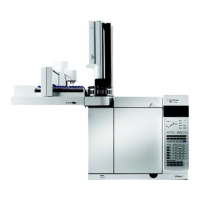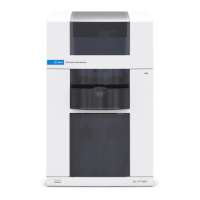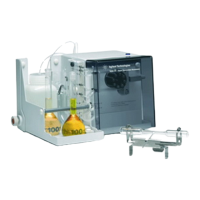Configuration 10
Operation Manual 157
A simple example
An analytical column is attached at its inlet end to a
split/splitless inlet located at the front of the GC and the
column outlet is attached to an FID located at the front
detector position.
Since only a single column is configured, the GC determines
that it controls the inlet pressure to the column by setting
the front inlet pressure and the outlet pressure is always
atmospheric. The GC can calculate a pressure for the front
inlet that can exactly overcome the resistance to flow
presented by this column at any point during a run.
Slightly more complex example
A precolumn is followed by a AUX 1 pressure controlled
splitter and two analytical columns. This requires three
column descriptions.
The GC can calculate the flow through the precolumn using
the precolumns physical properties to calculate the column’s
resistance to flow, along with the front inlet pressure and
the AUX 1 pressure. Your analytical method can set this flow
directly for the precolumn.
For the flow in the two parallel analytical columns 1 and 2,
the GC can use the column’s physical properties to calculate
the split flow through each individual column, at a given
AUX 1 pressure, with both columns exiting to atmospheric
pressure. Your analytical method can only set the flow for
the lowest numbered column in a split, analytical column 2.
If you try to set the flow for column #3, it will be ignored
and the flow for column #2 will be used.
Table 19 Analytical column
Column Inlet Outlet Thermal zone
Analytical column Front split/splitless Front FID GC oven
Table 20 Precolumn split to two analytical columns
Column Inlet Outlet Thermal zone
1 - Precolumn Front inlet AUX 1 GC oven
2 - Analytical column AUX 1 Front detector GC oven
3 - Analytical column AUX 1 Back detector GC oven

